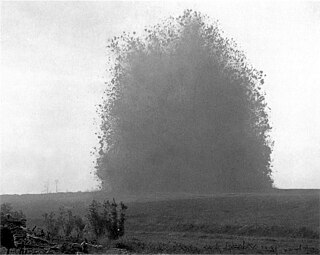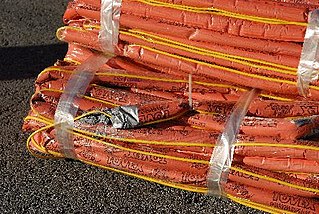
RDX (abbreviation of "Research Department eXplosive") or hexogen, among other names, is an organic compound with the formula (CH2N2O2)3. It is white, odorless and tasteless, widely used as an explosive. Chemically, it is classified as a nitroamine alongside HMX, which is a more energetic explosive than TNT. It was used widely in World War II and remains common in military applications.

Dynamite is an explosive made of nitroglycerin, sorbents, and stabilizers. It was invented by the Swedish chemist and engineer Alfred Nobel in Geesthacht, Northern Germany, and was patented in 1867. It rapidly gained wide-scale use as a more robust alternative to the traditional black powder explosives. It allows the use of nitroglycerine's favorable explosive properties while greatly reducing its risk of accidental detonation.

An explosive is a reactive substance that contains a great amount of potential energy that can produce an explosion if released suddenly, usually accompanied by the production of light, heat, sound, and pressure. An explosive charge is a measured quantity of explosive material, which may either be composed solely of one ingredient or be a mixture containing at least two substances.

Trinitrotoluene, more commonly known as TNT, more specifically 2,4,6-trinitrotoluene, and by its preferred IUPAC name 2-methyl-1,3,5-trinitrobenzene, is a chemical compound with the formula C6H2(NO2)3CH3. TNT is occasionally used as a reagent in chemical synthesis, but it is best known as an explosive material with convenient handling properties. The explosive yield of TNT is considered to be the standard comparative convention of bombs and asteroid impacts. In chemistry, TNT is used to generate charge transfer salts.

Ammonium nitrate is a chemical compound with the formula NH4NO3. It is a white crystalline salt consisting of ions of ammonium and nitrate. It is highly soluble in water and hygroscopic as a solid, although it does not form hydrates. It is predominantly used in agriculture as a high-nitrogen fertilizer.

ANFO ( AN-foh) (or AN/FO, for ammonium nitrate/fuel oil) is a widely used bulk industrial explosive. It consists of 94% porous prilled ammonium nitrate (NH4NO3) (AN), which acts as the oxidizing agent and absorbent for the fuel, and 6% number 2 fuel oil (FO). The use of ANFO originated in the 1950s.
Nitromethane, sometimes shortened to simply "nitro", is an organic compound with the chemical formula CH
3NO
2. It is the simplest organic nitro compound. It is a polar liquid commonly used as a solvent in a variety of industrial applications such as in extractions, as a reaction medium, and as a cleaning solvent. As an intermediate in organic synthesis, it is used widely in the manufacture of pesticides, explosives, fibers, and coatings. Nitromethane is used as a fuel additive in various motorsports and hobbies, e.g. Top Fuel drag racing and miniature internal combustion engines in radio control, control line and free flight model aircraft.

A shell, in a military context, is a projectile whose payload contains an explosive, incendiary, or other chemical filling. Originally it was called a bombshell, but "shell" has come to be unambiguous in a military context. A shell can hold a tracer.

Ammonal is an explosive made up of ammonium nitrate and aluminium powder, not to be confused with T-ammonal which contains trinitrotoluene as well to increase properties such as brisance. The mixture is often referred to as Tannerite, which is a brand of ammonal.

Composition B, also known as Hexotol and Hexolite, is a high explosive consisting of castable mixtures of RDX and TNT. It is used as the main explosive filling in artillery projectiles, rockets, land mines, hand grenades and various other munitions. It was also used for the explosive lenses in the first implosion-type nuclear weapons developed by the United States.
This article explains terms used for the British Armed Forces' ordnance (weapons) and ammunition. The terms may have different meanings depending on its usage in another country's military.
Astrolite is the trade name of a family of explosives, invented by chemist Gerald Hurst in the 1960s during his employment with the Atlas Powder Company. The Astrolite family consists of two compounds, Astrolite G and Astrolite A. Both are two-part liquid-state high explosive mixtures, composed of ammonium nitrate oxidizer and hydrazine rocket fuel. The explosives were extensively studied, manufactured, and used in many countries because of their advantages of high energy, excellent performance, and wide application. They still find some use in commercial and civil blasting applications, but have mostly been superseded by cheaper and safer compounds, largely due to the expense and exceptionally poisonous nature of the hydrazine component.
Minol is a military explosive developed by the Admiralty early in the Second World War to augment supplies of trinitrotoluene (TNT) and RDX, which were in short supply. The aluminium component in Minol significantly prolongs the explosive pulse, making it ideal for use in underwater naval weapons where munitions with a longer explosive pulse are more destructive than those with high brisance. Minol cannot be used in weapons fired from gun barrels because there is a risk of detonation when subjected to over 250 gs of acceleration. Initially, three Minol formulas were used. All percentages shown are by weight:
Composition H-6 is a melt-cast military aluminized high explosive. H-6 was developed in the US
Oxygen balance is an expression that is used to indicate the degree to which an explosive can be oxidized, to determine if an explosive molecule contains enough oxygen to fully oxidize the other atoms in the explosive. For example, fully oxidized carbon forms carbon dioxide, hydrogen forms water, sulfur forms sulfur dioxide, and metals form metal oxides. A molecule is said to have a positive oxygen balance if it contains more oxygen than is needed and a negative oxygen balance if it contains less oxygen than is needed.

The SC 250 was an air-dropped general purpose high-explosive bomb built by Germany during World War II and used extensively during that period. It could be carried by almost all German bomber aircraft, and was used to notable effect by the Junkers Ju 87 Stuka. The bomb's weight was about 250 kg, from which its designation was derived.
Picratol is a high explosive mixture, comprising 52% 'Explosive D' and 48% TNT. It has a detonation velocity of approximately 6,972 metres per second. Picratol has no civilian applications. It was exclusively intended for military use and was especially popular during the Second World War. The basic advantage of Picratol is its insensitivity to shock. As a result, it proved useful as the main explosive filling in armour-piercing shells and aerial bombs.

Methylammonium nitrate is an explosive chemical with the molecular formula CH6N2O3, alternately CH3NH3+NO3−. It is the salt formed by the neutralization of methylamine with nitric acid. This substance is also known as methylamine nitrate and monomethylamine nitrate, not to be confused with methyl nitramine or monomethyl nitramine.
Explosive materials are produced in numerous physical forms for their use in mining, engineering, or military applications. The different physical forms and fabrication methods are grouped together in several use forms of explosives.

A water-gel explosive is a fuel sensitized explosive mixture consisting of an aqueous ammonium nitrate solution that acts as the oxidizer. Water gels that are cap-insensitive are referred to under United States safety regulations as blasting agents. Water gel explosives have a jelly-like consistency and come in sausage-like packing stapled shut on both sides.












